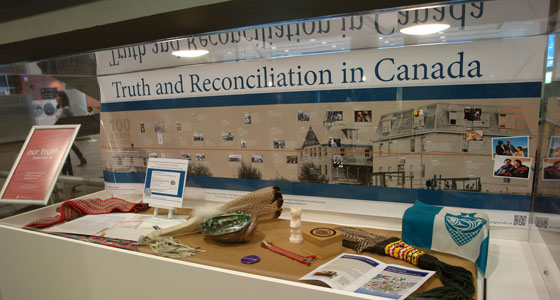 On September 18, 2013, UBC took the extraordinary step of suspending almost all classes on its Vancouver campus to give students, faculty, and other members of the UBC community the opportunity to more fully engage and participate in the historic Truth and Reconciliation Commission of Canada (TRC) National Event. Many faculty, staff, and students took the opportunity to attend events across campus, engage in dialogue, and learn more about the Indian Residential School experience and its impact on Aboriginal communities.
On September 18, 2013, UBC took the extraordinary step of suspending almost all classes on its Vancouver campus to give students, faculty, and other members of the UBC community the opportunity to more fully engage and participate in the historic Truth and Reconciliation Commission of Canada (TRC) National Event. Many faculty, staff, and students took the opportunity to attend events across campus, engage in dialogue, and learn more about the Indian Residential School experience and its impact on Aboriginal communities.
Professor of Teaching and Associate Head of Biology, Shona Ellis, and Botany and Zoology Instructor, Pam Kalas, were able to engage over 200 students in BIOL 121 Genetics, Evolution and Ecology, with the TRC. They did this by starting a blog with their students, to ensure that engagement didn’t end on September 18. The blog provided a space where students could reflect on their engagement with September 18, and how they were learning more about Indian Residential Schools. Students also talked about some of the spaces on campus that they visited during the Truth and Reconciliation Commission.
The students were also engaging with the TRC throughout the course. On September 16, the students were involved in interactive in-class activities, and Pam could see that the event had a large impact on them. “When doing the activities with the students, it became obvious that they could see connections more clearly than I could,” she noted. Then, on September 18, all students were asked to engage with events that were taking place both on and off campus, as part of the TRC. For example, students could attend the event at the UBC Longhouse, visit exhibits at the Belkin Art Gallery and the Museum of Anthropology, and/or attend the event at the Pacific National Exhibition (PNE).
There was also a follow-up assignment where students had to describe the event, and reflect on what they learned and how it affected them. “The whole event didn’t hit until the event at the Longhouse brought everything together with the testimonials,” said Shona. During that day, instructors and students from the biology program shared a number of displays. Each instructor picked a topic to investigate how biology and First Nations intersect. Shona focused on the science of cedar, Pam explored the genetics of the Komodi Bear, and Liane Chen (BIOL 200 and 341) looked at the Coast Salish wool dog.
When asked about how they were able to engage a class of over 200 students, Pam explained that she started early and planned ahead. She also explored new programming and started engaging with it. Through her involvement, Pam felt that the TRC gave her the opportunity to re-connect with her initial curiosity about Canada and First Nations peoples. Shona was inspired to visit Alert Bay to see an Indian Residential School and learn more about this part of First Nations history, something she hadn’t learned about, even though she grew up close to a First Nations community.
As for future plans, Shona, Pam, and Liane would like to look for ways to connect with experts, as they feel that traditional knowledge can enrich their teaching. “I feel like we’re at the beginning, and we have the momentum. Truth and reconciliation has made people more open and able to talk about issues and acknowledge our shared history,” said Shona. “We’re proud of UBC for engaging with the TRC and giving us the opportunity to learn.”
This article was published in the January 2014 CTLT Newsletter, Dialogues. Below is a list of the articles included in the issue:
- CTLT Institute 2014 – Call for Contributions
- Save the Date! STLHE 2015
- Lynda.com Pilot at UBC: Only 8 Weeks of Unlimited Online Learning Access Left
- Truth and Reconciliation at UBC: Engaging Biology Students with the TRC (currently viewing)
- Truth and Reconciliation at UBC: Continuing the Conversation
Find out more information about the CTLT Newsletter, Dialogues.

